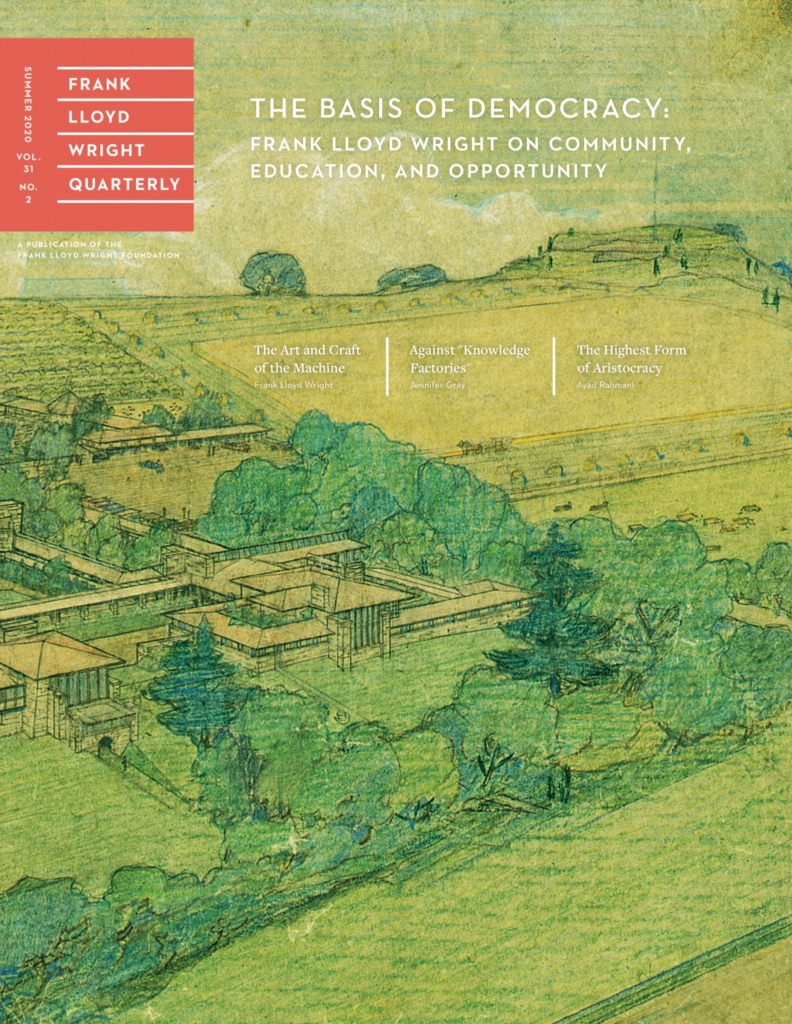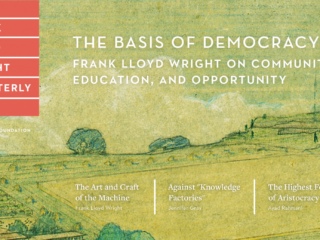
The Art & Craft of the Machine
Frank Lloyd Wright | Apr 7, 2021
This essay excerpt has been taken from one of Frank Lloyd Wright’s earliest and most seminal lectures where he seized upon the ways in which industry, education, and architecture could foster more inclusive and equal communities.
Introduction by Jennifer Gray, guest editor of the Summer 2020 Frank Lloyd Wright Quarterly, The Basis of Democracy: Frank Lloyd Wright on Community, Education, and Opportunity.
In 1901 Frank Lloyd Wright delivered a seminal address called “The Art and Craft of the Machine” to an audience at Hull House, an organization that offered social services, such as education, childcare, and legal aid, to poor communities in Chicago. The themes Wright outlined in his talk would preoccupy him throughout his life, namely the relationship between machines, education, architecture, and democracy. Calling the machine “the great forerunner of democracy,” Wright invokes an argument advanced by the French author Victor Hugo in Notre-Dame de Paris in 1831 that reflects on the power of the printed word. Before the age of Gutenberg, architecture centered on the handicrafts and was the “universal writing of humanity.” The invention of the printing press—arguably the first great machine, Wright points out— transformed architecture but also social relations. Books democratized access to knowledge. While any individual book may appear ephemeral or fragile, the sheer number of them, the number of people reading them, and the ability to reprint them renders “printed thought … imperishable … indestructible.” Widespread literacy and access to knowledge ultimately contributed to the democratic revolutions of the eighteenth century, including the American Revolution.
Wright embraces the machine, broadly speaking, as capable of reducing human labor and expanding lives and “thereby the basis of the Democracy upon which we insist.” From the standpoint of architecture, the machine reduces waste and lowers costs so that “the poor as well as the rich may enjoy to-day the beautiful surface treatments of clean, strong forms.” Indeed throughout his career Wright would experiment with various ways to harness the advantages of machine production to design quality, affordable housing for large numbers of people. Wright laments, towards the end of his essay, that education in America has not forged connections yet between “Science and Art” or adopted curriculums of “nature-study.” However progressive educators, such as John Dewey, who founded the experimental Laboratory School at the University of Chicago in 1896, and Wright’s own aunts, Jane and Ellen Lloyd Jones, founders of Hillside Home School in 1886, were in fact advancing new pedagogical models centered on active learning from experience and on unifying practical or manual training with intellectual pursuit. Informed by their theories, Wright ultimately attempted to bind together these forces— education, machines, architecture, and democracy—when he founded the Taliesin Fellowship in the 1930s.
… The Machine was the great forerunner of democracy.
•
That the Machine has dealt Art in the grand old sense a death-blow, none will deny. The evidence is too substantial.
•
Art in the grand old sense—meaning Art in the sense of structural tradition, whose craft is fashioned upon the handicraft ideal, ancient or modern; an art wherein this form and that form as structural parts were laboriously joined in such a way as to beautifully emphasize the manner of the joining: the million and one ways of beautifully satisfying bare structural necessities, which have come down to us chiefly through the books as “Art.”
For the purpose of suggesting hastily and therefore crudely wherein the machine has sapped the vitality of this art, let us assume Architecture in the old sense as a fitting representative of Traditional-art, and Printing as a fitting representation of the Machine.
What printing—the machine—has done for architecture— the fine art—will have been done in measure of time for all art immediately fashioned upon the early handicraft ideal.
With a masterful hand Victor Hugo, a noble lover and a great student of architecture, traces her fall in “Notre Dame.”
The prophecy of Frollo, that “The book will kill the edifice,” I remember was to me as a boy one of the grandest sad things of the world.
After seeking the origin and tracing the growth of architecture in superb fashion, showing how in middle ages all the intellectual forces of the people converged to one point—architecture—he shows how, in the life of that time, whoever was born poet became an architect. All other arts simply obeyed and placed themselves under the discipline of architecture. The were the workmen of the great work. The architect, the poet, the master, summed up in his person the sculpture and windows, music which set his bells to pealing and breathed into his organs—there was nothing which was not forced in order to make something of itself in that time, to come and frame itself in the edifice.
Thus down to the time of Gutenberg architecture is the principal writing—the universal writing of humanity.
•
In the fifteenth century everything changes.
Human thought discovers a mode of perpetuating itself, not only more resisting than architecture, but still more simple and easy.
Architecture is dethroned.
Guttenberg’s letters of lead are about to supersede Orpheus’ letters of stone.
The book is about to kill the edifice.
The invention of printing was the greatest event in history. It was the first great machine, after the great city.
It is human thought stripping off one form and donning another.
Printed, thought is more imperishable than ever—it is volatile, indestructible.
•
All the life, leaving architecture, comes to it. In proportion as architecture ebbs and flows, printing swells and grows. That capital of forces which human thought had been expending in building is hereafter to be expended in books; and architecture, as it was, is dead, irretrievably slain by the printed book; slain because it endures for a shorter time; slain because human thought has found a more simple medium of expression, which costs less in human effort; because human thought has been rendered volatile and indestructible, reaching uniformly and irresistibly the four corners of the earth and for all.
•
The Machine is Intellect mastering the drudgery of earth that plastic art may live; that the margin of leisure and strength by which man’s life upon the earth can be made beautiful, may immeasurably widen; its function ultimately to emancipate human expression!
•
It is not more likely that the medium of artistic expression itself has broadened and changed until a new definition and new direction must be given the art activity of the future, and that the Machine has finally made for the artist, whether he will yet own it or not, a splendid distinction between the Art of old and the Art to come? A distinction made by the tool which frees human labor, lengthens and broadens the life of the simplest man, thereby the basis of the Democracy upon which we insist.
•
Now let us learn from the Machine.
It teaches us that the beauty of wood lies first in its qualities as wood; no treatment that did not bring out these qualities all the time could be plastic, and therefore not appropriate—so not beautiful, the machine teaches us, if
we have left it to the machine that certain simple forms and handling are suitable to bring out the beauty of wood and certain forms are not; that all wood-carving is apt to be a forcing of the material, an insult to its finer possibilities as a material having in itself intrinsically artistic properties, of which its beautiful markings is one, its texture another, its color a third.
The machine, by its wonderful cutting, shaping, smoothing, and repetitive capacity, has made it possible to so use it without waste that the poor as well as the rich may enjoy to-day beautiful surface treatments of clean, strong forms …
•
I will venture to say, from personal observation and some experience, that not one artist in one hundred has taken pains to thus educate himself. I will go further and say what I believe to be true, that not one educational institution in America has as yet attempted to forge the connecting link between Science and Art by training the artist to his actual tools, or, by a process of nature-study that develops in him the power of independent thought, fitting him to use them properly.
•
Upon this faith in Art as the organic heart quality of the scientific frame of things, I base a belief that we must look to the artist brain, of all brains, to grasp the significance to society of this thing we call the Machine.

This essay by Frank Lloyd Wright, The Art & Craft of the Machine, originally appeared in the Summer 2020 member-exclusive Frank Lloyd Wright Quarterly magazine featuring guest editor Jennifer Gray.
To receive a subscription to this award-winning publication, become a member of the Frank Lloyd Wright Foundation today.




